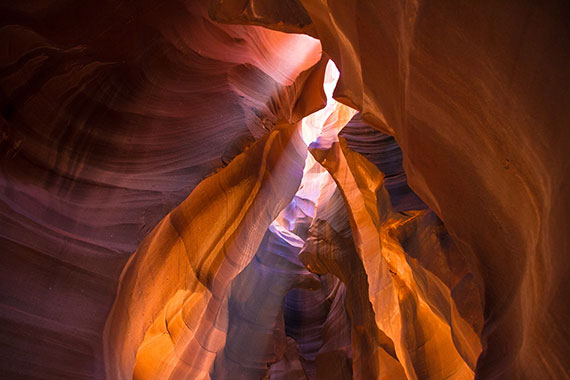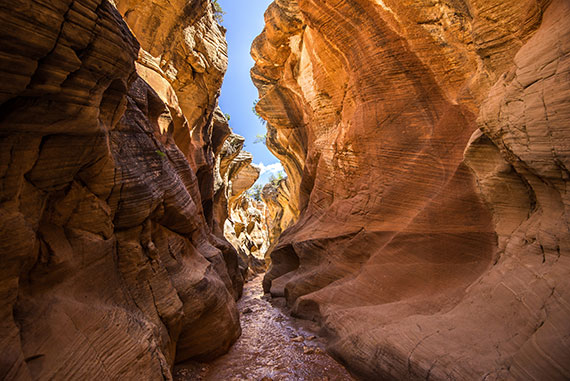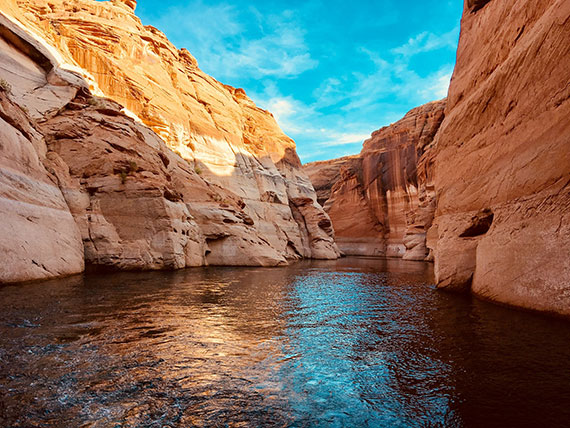Slot canyons represent one of the most fascinating corners of our planet: the American Southwest. Sandstone, over millions of years, has been eroded by the power of water, creating deep, winding corridors. For anyone of any age with an explorative spirit, slot canyons are a playground. The two most iconic, and likely the most photogenic canyons in the world, are within a two-hour drive of each other. They are the Zion Narrows and Antelope Canyon.

Photo by Hikersbay Hikersbay
My name is Seth Hamel. I’m a professional landscape and adventure photographer working in the Zion National Park area. When I go into the Narrows by myself or with clients, the start time isn’t until 10 am or so, depending on the time of year. Many of the clients that I guide through the Narrows ask, “Can we start earlier? I want to make sure I’m in there for the best light.” With typical landscape photography, we want to get that early, glowing light on the features of whatever we’re photographing.
In slot canyons, however, the best light occurs mid-day on cloudless, sunny days. The best light is not direct sunlight hitting the walls of the canyon but rather reflected light. Reflected light occurs when bright, harsh, direct sunlight hits a canyon wall and reflects that light onto another wall. This is the type of light that produces rich, saturated, glowing colors in slot canyons. It’s important to keep even a peep of sky or direct sunlight out of your photos, as this produces blown out areas of your image and can produce a nasty haze near those areas. Naturally, there are exceptions to this rule, but they are uncommon.

Photo by Scott Osborn
The Zion Narrows and Antelope Canyon are significantly different canyons.
The Zion Narrows is the largest slot canyon in the world! Carved by the power of the Virgin River, the Narrows is a canyon where you hike in the river itself. Antelope Canyon is a dry canyon unless there has been recent rainfall. Due to the narrowness of this canyon and its large water gathering area during the monsoon season, this canyon has been carved by powerful raging flash floods. Because of the differences between these canyons, camera settings can vary with each.
To obtain professional quality images, a tripod is required. As a general rule, setting your ISO to 100 will give you crisp, printable images. In canyons, you typically want to have the entire scene in focus–no blurring of the foreground or background (again this is a general rule). In order to obtain such depth of field, set your aperture to a higher number. F/16, f/18 or f/22 is useful. From there, read your camera’s internal light meter and adjust your shutter speed in order to get the appropriate exposure. These settings are a safe bet for Antelope Canyon.

Photo by Dave Dollar
The Zion Narrows presents situations where controlling your shutter speed is the first priority. Due to the beautiful flowing water in this magnificent canyon, controlling what the flowing water looks like plays a major role in the artistic outcome of your image.
Good shutter speeds range from 1/2 of a second to 1/10 of a second. This requires some experimentation with different speeds of water flow and the effect you’re hoping to achieve. After setting the shutter speed, I would adjust my aperture and then the ISO. This can be a tricky balance. Having an experienced mentor in this situation is helpful.
Slot canyons are amazingly beautiful and awe-inspiring. They are candy lands for any level of photographer. Keep in mind that during rainy periods, slot canyons are very dangerous due to flash flooding. Be sure to do your research on flash flooding and weather conditions before you enter into these canyons. There have been numbers of fatalities in both of these canyons.
About the Author
Seth Hamel offers professional guiding and photography instruction in Zion National Park. Tracking the best light in the Zion Narrows throughout the year, you are guaranteed to have the opportunity to shoot some of the best scenes in the canyon. Learn more about available guided Zion photography opportunities at zion-photography.com. Along with artistic and technical instruction, you will be walking away with professional quality images that will be some of your favorite images from the desert Southwest.
Like This Article?
Don't Miss The Next One!
Join over 100,000 photographers of all experience levels who receive our free photography tips and articles to stay current:






Steve–thanks so much for the helpful info. I only have one camera body now, but I will be in the area for two days, so I could always make second trips to the upper and lower canyons with different lenses. The lower canyon is at the top of my list because it is supposed to be less crowded.
And, thanks for the tip re: Lake Powell and the other possibilities. I’m hoping for clear nighttime skies so I can get some night shots.
Best wishes and thanks again!
Mario,
I too have been there several times. The opportunities range from very wide to telephoto. A friend who shoots for Nat Geo carries two cameras bodies on a double rapid strap, with different lenses to prevent the dust situation and, in her case, to instantly have the lens she wants or needs for her photo agenda. Inside the canyon you will probably not have the instant need as opposed to people or animal shots, however you can make things easier if you have the options. I have used lenses there from a 15mm fisheye to a 100-400. The opportunities are almost endless. Some photographers set a challenge for themselves to do a series in some situation with only one lens ( usually one focal length and not a zoom) The choice is yours. If you take two photographers with the same lens and bodies in the same location, you will get two different series of photos unless they chose to shoot at the exact same object from the exact same location. Whatever your choice, it is a fantastic place and you will want to return. Don’t forget the other opportunities nearby, Horseshoe Bend, Lake Powell, etc. One more thing. The opportunities of shooting extend both before and after sunrise and sunset. Your exposure can make near dark look like daylight. Try shooting Navajo Mountain across Lake Powell after sunset while the earth’s shadow rises ( the terminator) in the sky behind the the peak. The magenta color of the shadow plus the soft lighting after sunset makes an interesting image and not one you see that often. Look at a lot of Antelope Canyon images before you go there and then look for other places to shoot as the opportunities to make unique images abound if you look for them. Have fun, I usually go to lower Antelope since it is not as commercialized.
Great article and very helpful!
Question: I’m visiting the Antelope canyons in December. I know that they are very dusty so I don’t want to be changing lenses. I shoot with an APS-C sensor (Nikon D7000) so I’m wondering if you recommend a very wide angle lens (12-24) or my 18-200.
Thanks for your input.
Hi guys!!
Going to Zion this summer and planning on taking a few slot canyon pictures at peek a boo at Bryce. I own a 18-55 mm and a 70-300 mm lens and since dust is an issue, I am trying to avoid having to switch back and forward. What would your recommendation be in terms of which lens I should take?
I am worried the 70-300 might be too close up and wouldn’t give me any room to shoot but I’ve never been to a canyon before so I have no clue on what the shooting distances might be.
Thanks!
Both the article by Seth and the comments by Steve are very helpful. A question to Seth, for shooting inside the Upper Antelope Canyon, given a 16-35 f4 or a 24-70 f2.8 zoom on a 5D body, which lens would you prefer? Thanks.
Try not to stick with a certain model.